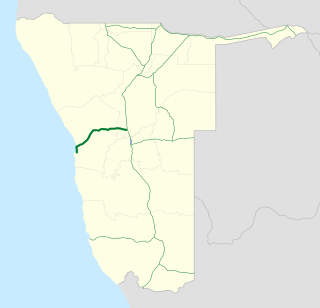This article deals with the system of transport in Namibia, both public and private.

Gobabis is a town in eastern Namibia. It is the regional capital of the Omaheke Region, and the district capital of the Gobabis electoral constituency. Gobabis is situated 200 km (120 mi) down the B6 motorway from Windhoek to Botswana. The town is 113 km (70 mi) from the Buitepos border post with Botswana, and serves as an important link to South Africa on the tarred Trans-Kalahari Highway. Gobabis is in the heart of the cattle farming area. In fact Gobabis is so proud of its cattle farming that a statue of a large Brahman bull with the inscription "Cattle Country" greets visitors to the town. Gobabis also has its own local airport.

The Walvis Bay-Ndola-Lubumbashi Development Road, formerly known as the Trans-Caprivi Corridor and until 2004 the Trans-Caprivi Highway, begins in Walvis Bay. It runs through Rundu in northeastern Namibia and along the Caprivi Strip to Katima Mulilo on the Zambezi River, which forms the border between Namibia and Zambia. The Katima Mulilo Bridge spans the river to the Zambian town of Sesheke. From there, the road continues as the M10 Road to Livingstone, where it connects to the main north–south highway to Lusaka and extends to the Copperbelt.

The N4 is a national route in South Africa that runs from Skilpadshek on the Botswana border, past Rustenburg, Pretoria, eMalahleni and Mbombela, to Komatipoort on the Mozambique border. The entire route is a toll road.

TransNamib Holdings Limited, commonly referred to as TransNamib, is a state-owned railway company in Namibia. Organised as a holding company, it provides both rail and road freight services, as well as passenger rail services. Its headquarters are in the country’s capital Windhoek.

The Namibia Premier League (NPL) was the highest level of domestic association football in Namibia until it was disbanded following the 2018-19 season. The league was established in 1990 and was trimmed to 12 teams from the traditional 16 in 2005. It was disbanded in 2020 after ongoing problems with the Namibia Football Association, which finally ended their relationship. The NFA founded the Namibia Football Premier League to replace it. The new league kicked off with the 2022-2023 season with African Stars against Unam at the Hage Geingob Rugby Stadium.

Rail services in Botswana are provided by Botswana Railways. Most routes in the country radiate from Gaborone. The railway network consists of 888 km of track; its gauge is 1,067 mm cape gauge.
The Platinum Highway is part of the N4 route, and a major South African highway built under concessions with a private contractor. In 2001, the project was voted Infrastructure Deal of the Year by Project Finance International Magazine. It took eight years to complete. The highway is part of the Trans-Kalahari Corridor, which links four African countries and two oceans. The contract had tougher concession terms than were seen in previous contracts.

Vehicle registration plates of Namibia are yellow fluorescent metal plates with imprints in black. The standard version is uniform throughout the country, and carries one of the following forms:
List of Railway stations in Botswana include:

Buitepos is a small settlement in the Omaheke Region in eastern Namibia. It is situated on the national road B6 which is part of the Trans-Kalahari Highway, and a border post between Namibia and Botswana. The proposed Trans-Kalahari Railway may pass through this place, too.

The A2 highway is a road in Botswana running from the Namibian border at Buitepos through Jwaneng, Kanye and Lobatse to the South African border at Pioneer Gate, thus connecting 3 countries.

B2 is a major road in Namibia. The highway runs east–west between the major sea port of Walvis Bay and the nation's capital Windhoek.

The B1 is a national highway of Namibia, and is the country's longest and most significant road, running the length of the country from south to north. It connects Noordoewer in the south on the South African border with Oshikango in the north on the Angolan border via Namibia's capital city Windhoek.

B6 is a national highway of eastern-central Namibia. It is 318 kilometres (198 mi) long and connects the capital Windhoek with the Buitepos border crossing to Botswana. Gobabis, the capital of Omaheke Region, lies on the B6, as do the villages of Seeis, Omitara and Witvlei. Hosea Kutako International Airport is also located on the B6, east of Windhoek.

Okahandja railway station is a railway station serving the town of Okahandja in Namibia. It is part of the TransNamib Railway.

The rail service in Namibia is provided by TransNamib. The Namibian rail network consists of 2,687 km of tracks (2017).

The A1 is a national highway in Namibia. The 76 kilometres (47 mi) stretch of road between Windhoek and Okahandja is the only A-rated road in Namibia. Consisting of freeway for its entire length, it came into existence in 2017 when freeway sections of the B1 were redesignated A1 in accordance with new standards of the Roads Authority Namibia. The entirety of the A1 forms part of the Trans-Kalahari Corridor and, together with the B1, also forms part of the Tripoli-Cape Town Highway.
The Trans-Kalahari Railway is a planned railway line that will connect the port city of Walvis Bay in Namibia to Gaborone, the capital of Botswana. This proposed railway line aims to improve regional trade and economic development by providing a more efficient and cost-effective transportation route for goods being exported from Botswana, Namibia, and Southern Africa more generally.
















